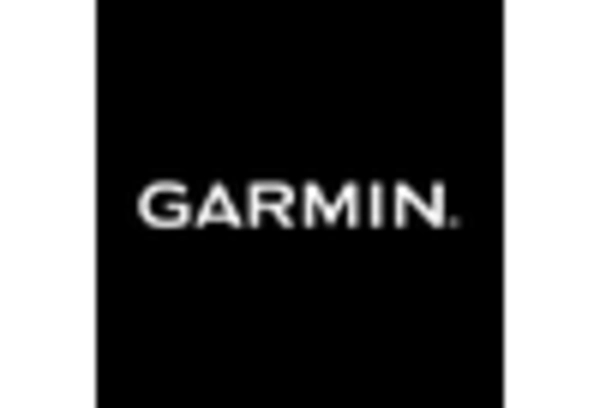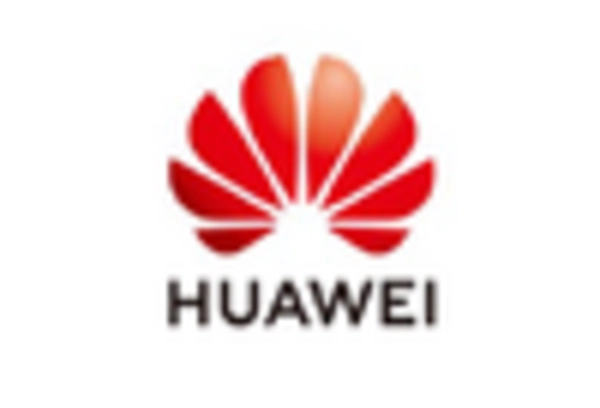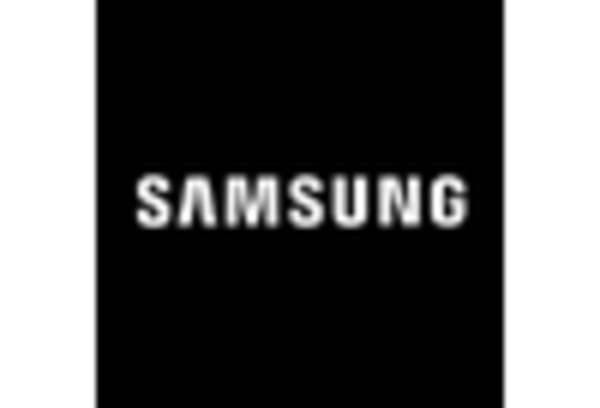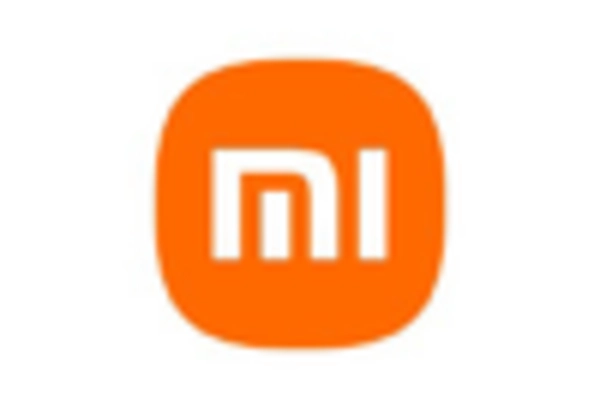Wearable Fitness Trackers
Smartwatches
Fitness Bands
Heart Rate Monitors
Activity Tracking
Health Monitoring
Sleep Tracking
Fitness Coaching
Online Retail
Offline Retail
Direct Sales
Individuals
Fitness Enthusiasts
Healthcare Professionals
North America
Europe
South America
Asia Pacific
Middle East and Africa
North America Outlook (USD Billion, 2019-2035)
North America Fitness Tracker Market by Product Type
Wearable Fitness Trackers
Smartwatches
Fitness Bands
Heart Rate Monitors
North America Fitness Tracker Market by Application Type
Activity Tracking
Health Monitoring
Sleep Tracking
Fitness Coaching
North America Fitness Tracker Market by Distribution Channel Type
Online Retail
Offline Retail
Direct Sales
North America Fitness Tracker Market by End User Type
Individuals
Fitness Enthusiasts
Healthcare Professionals
North America Fitness Tracker Market by Regional Type
US
Canada
US Outlook (USD Billion, 2019-2035)
US Fitness Tracker Market by Product Type
Wearable Fitness Trackers
Smartwatches
Fitness Bands
Heart Rate Monitors
US Fitness Tracker Market by Application Type
Activity Tracking
Health Monitoring
Sleep Tracking
Fitness Coaching
US Fitness Tracker Market by Distribution Channel Type
Online Retail
Offline Retail
Direct Sales
US Fitness Tracker Market by End User Type
Individuals
Fitness Enthusiasts
Healthcare Professionals
CANADA Outlook (USD Billion, 2019-2035)
CANADA Fitness Tracker Market by Product Type
Wearable Fitness Trackers
Smartwatches
Fitness Bands
Heart Rate Monitors
CANADA Fitness Tracker Market by Application Type
Activity Tracking
Health Monitoring
Sleep Tracking
Fitness Coaching
CANADA Fitness Tracker Market by Distribution Channel Type
Online Retail
Offline Retail
Direct Sales
CANADA Fitness Tracker Market by End User Type
Individuals
Fitness Enthusiasts
Healthcare Professionals
Europe Outlook (USD Billion, 2019-2035)
Europe Fitness Tracker Market by Product Type
Wearable Fitness Trackers
Smartwatches
Fitness Bands
Heart Rate Monitors
Europe Fitness Tracker Market by Application Type
Activity Tracking
Health Monitoring
Sleep Tracking
Fitness Coaching
Europe Fitness Tracker Market by Distribution Channel Type
Online Retail
Offline Retail
Direct Sales
Europe Fitness Tracker Market by End User Type
Individuals
Fitness Enthusiasts
Healthcare Professionals
Europe Fitness Tracker Market by Regional Type
Germany
UK
France
Russia
Italy
Spain
Rest of Europe
GERMANY Outlook (USD Billion, 2019-2035)
GERMANY Fitness Tracker Market by Product Type
Wearable Fitness Trackers
Smartwatches
Fitness Bands
Heart Rate Monitors
GERMANY Fitness Tracker Market by Application Type
Activity Tracking
Health Monitoring
Sleep Tracking
Fitness Coaching
GERMANY Fitness Tracker Market by Distribution Channel Type
Online Retail
Offline Retail
Direct Sales
GERMANY Fitness Tracker Market by End User Type
Individuals
Fitness Enthusiasts
Healthcare Professionals
UK Outlook (USD Billion, 2019-2035)
UK Fitness Tracker Market by Product Type
Wearable Fitness Trackers
Smartwatches
Fitness Bands
Heart Rate Monitors
UK Fitness Tracker Market by Application Type
Activity Tracking
Health Monitoring
Sleep Tracking
Fitness Coaching
UK Fitness Tracker Market by Distribution Channel Type
Online Retail
Offline Retail
Direct Sales
UK Fitness Tracker Market by End User Type
Individuals
Fitness Enthusiasts
Healthcare Professionals
FRANCE Outlook (USD Billion, 2019-2035)
FRANCE Fitness Tracker Market by Product Type
Wearable Fitness Trackers
Smartwatches
Fitness Bands
Heart Rate Monitors
FRANCE Fitness Tracker Market by Application Type
Activity Tracking
Health Monitoring
Sleep Tracking
Fitness Coaching
FRANCE Fitness Tracker Market by Distribution Channel Type
Online Retail
Offline Retail
Direct Sales
FRANCE Fitness Tracker Market by End User Type
Individuals
Fitness Enthusiasts
Healthcare Professionals
RUSSIA Outlook (USD Billion, 2019-2035)
RUSSIA Fitness Tracker Market by Product Type
Wearable Fitness Trackers
Smartwatches
Fitness Bands
Heart Rate Monitors
RUSSIA Fitness Tracker Market by Application Type
Activity Tracking
Health Monitoring
Sleep Tracking
Fitness Coaching
RUSSIA Fitness Tracker Market by Distribution Channel Type
Online Retail
Offline Retail
Direct Sales
RUSSIA Fitness Tracker Market by End User Type
Individuals
Fitness Enthusiasts
Healthcare Professionals
ITALY Outlook (USD Billion, 2019-2035)
ITALY Fitness Tracker Market by Product Type
Wearable Fitness Trackers
Smartwatches
Fitness Bands
Heart Rate Monitors
ITALY Fitness Tracker Market by Application Type
Activity Tracking
Health Monitoring
Sleep Tracking
Fitness Coaching
ITALY Fitness Tracker Market by Distribution Channel Type
Online Retail
Offline Retail
Direct Sales
ITALY Fitness Tracker Market by End User Type
Individuals
Fitness Enthusiasts
Healthcare Professionals
SPAIN Outlook (USD Billion, 2019-2035)
SPAIN Fitness Tracker Market by Product Type
Wearable Fitness Trackers
Smartwatches
Fitness Bands
Heart Rate Monitors
SPAIN Fitness Tracker Market by Application Type
Activity Tracking
Health Monitoring
Sleep Tracking
Fitness Coaching
SPAIN Fitness Tracker Market by Distribution Channel Type
Online Retail
Offline Retail
Direct Sales
SPAIN Fitness Tracker Market by End User Type
Individuals
Fitness Enthusiasts
Healthcare Professionals
REST OF EUROPE Outlook (USD Billion, 2019-2035)
REST OF EUROPE Fitness Tracker Market by Product Type
Wearable Fitness Trackers
Smartwatches
Fitness Bands
Heart Rate Monitors
REST OF EUROPE Fitness Tracker Market by Application Type
Activity Tracking
Health Monitoring
Sleep Tracking
Fitness Coaching
REST OF EUROPE Fitness Tracker Market by Distribution Channel Type
Online Retail
Offline Retail
Direct Sales
REST OF EUROPE Fitness Tracker Market by End User Type
Individuals
Fitness Enthusiasts
Healthcare Professionals
APAC Outlook (USD Billion, 2019-2035)
APAC Fitness Tracker Market by Product Type
Wearable Fitness Trackers
Smartwatches
Fitness Bands
Heart Rate Monitors
APAC Fitness Tracker Market by Application Type
Activity Tracking
Health Monitoring
Sleep Tracking
Fitness Coaching
APAC Fitness Tracker Market by Distribution Channel Type
Online Retail
Offline Retail
Direct Sales
APAC Fitness Tracker Market by End User Type
Individuals
Fitness Enthusiasts
Healthcare Professionals
APAC Fitness Tracker Market by Regional Type
China
India
Japan
South Korea
Malaysia
Thailand
Indonesia
Rest of APAC
CHINA Outlook (USD Billion, 2019-2035)
CHINA Fitness Tracker Market by Product Type
Wearable Fitness Trackers
Smartwatches
Fitness Bands
Heart Rate Monitors
CHINA Fitness Tracker Market by Application Type
Activity Tracking
Health Monitoring
Sleep Tracking
Fitness Coaching
CHINA Fitness Tracker Market by Distribution Channel Type
Online Retail
Offline Retail
Direct Sales
CHINA Fitness Tracker Market by End User Type
Individuals
Fitness Enthusiasts
Healthcare Professionals
INDIA Outlook (USD Billion, 2019-2035)
INDIA Fitness Tracker Market by Product Type
Wearable Fitness Trackers
Smartwatches
Fitness Bands
Heart Rate Monitors
INDIA Fitness Tracker Market by Application Type
Activity Tracking
Health Monitoring
Sleep Tracking
Fitness Coaching
INDIA Fitness Tracker Market by Distribution Channel Type
Online Retail
Offline Retail
Direct Sales
INDIA Fitness Tracker Market by End User Type
Individuals
Fitness Enthusiasts
Healthcare Professionals
JAPAN Outlook (USD Billion, 2019-2035)
JAPAN Fitness Tracker Market by Product Type
Wearable Fitness Trackers
Smartwatches
Fitness Bands
Heart Rate Monitors
JAPAN Fitness Tracker Market by Application Type
Activity Tracking
Health Monitoring
Sleep Tracking
Fitness Coaching
JAPAN Fitness Tracker Market by Distribution Channel Type
Online Retail
Offline Retail
Direct Sales
JAPAN Fitness Tracker Market by End User Type
Individuals
Fitness Enthusiasts
Healthcare Professionals
SOUTH KOREA Outlook (USD Billion, 2019-2035)
SOUTH KOREA Fitness Tracker Market by Product Type
Wearable Fitness Trackers
Smartwatches
Fitness Bands
Heart Rate Monitors
SOUTH KOREA Fitness Tracker Market by Application Type
Activity Tracking
Health Monitoring
Sleep Tracking
Fitness Coaching
SOUTH KOREA Fitness Tracker Market by Distribution Channel Type
Online Retail
Offline Retail
Direct Sales
SOUTH KOREA Fitness Tracker Market by End User Type
Individuals
Fitness Enthusiasts
Healthcare Professionals
MALAYSIA Outlook (USD Billion, 2019-2035)
MALAYSIA Fitness Tracker Market by Product Type
Wearable Fitness Trackers
Smartwatches
Fitness Bands
Heart Rate Monitors
MALAYSIA Fitness Tracker Market by Application Type
Activity Tracking
Health Monitoring
Sleep Tracking
Fitness Coaching
MALAYSIA Fitness Tracker Market by Distribution Channel Type
Online Retail
Offline Retail
Direct Sales
MALAYSIA Fitness Tracker Market by End User Type
Individuals
Fitness Enthusiasts
Healthcare Professionals
THAILAND Outlook (USD Billion, 2019-2035)
THAILAND Fitness Tracker Market by Product Type
Wearable Fitness Trackers
Smartwatches
Fitness Bands
Heart Rate Monitors
THAILAND Fitness Tracker Market by Application Type
Activity Tracking
Health Monitoring
Sleep Tracking
Fitness Coaching
THAILAND Fitness Tracker Market by Distribution Channel Type
Online Retail
Offline Retail
Direct Sales
THAILAND Fitness Tracker Market by End User Type
Individuals
Fitness Enthusiasts
Healthcare Professionals
INDONESIA Outlook (USD Billion, 2019-2035)
INDONESIA Fitness Tracker Market by Product Type
Wearable Fitness Trackers
Smartwatches
Fitness Bands
Heart Rate Monitors
INDONESIA Fitness Tracker Market by Application Type
Activity Tracking
Health Monitoring
Sleep Tracking
Fitness Coaching
INDONESIA Fitness Tracker Market by Distribution Channel Type
Online Retail
Offline Retail
Direct Sales
INDONESIA Fitness Tracker Market by End User Type
Individuals
Fitness Enthusiasts
Healthcare Professionals
REST OF APAC Outlook (USD Billion, 2019-2035)
REST OF APAC Fitness Tracker Market by Product Type
Wearable Fitness Trackers
Smartwatches
Fitness Bands
Heart Rate Monitors
REST OF APAC Fitness Tracker Market by Application Type
Activity Tracking
Health Monitoring
Sleep Tracking
Fitness Coaching
REST OF APAC Fitness Tracker Market by Distribution Channel Type
Online Retail
Offline Retail
Direct Sales
REST OF APAC Fitness Tracker Market by End User Type
Individuals
Fitness Enthusiasts
Healthcare Professionals
South America Outlook (USD Billion, 2019-2035)
South America Fitness Tracker Market by Product Type
Wearable Fitness Trackers
Smartwatches
Fitness Bands
Heart Rate Monitors
South America Fitness Tracker Market by Application Type
Activity Tracking
Health Monitoring
Sleep Tracking
Fitness Coaching
South America Fitness Tracker Market by Distribution Channel Type
Online Retail
Offline Retail
Direct Sales
South America Fitness Tracker Market by End User Type
Individuals
Fitness Enthusiasts
Healthcare Professionals
South America Fitness Tracker Market by Regional Type
Brazil
Mexico
Argentina
Rest of South America
BRAZIL Outlook (USD Billion, 2019-2035)
BRAZIL Fitness Tracker Market by Product Type
Wearable Fitness Trackers
Smartwatches
Fitness Bands
Heart Rate Monitors
BRAZIL Fitness Tracker Market by Application Type
Activity Tracking
Health Monitoring
Sleep Tracking
Fitness Coaching
BRAZIL Fitness Tracker Market by Distribution Channel Type
Online Retail
Offline Retail
Direct Sales
BRAZIL Fitness Tracker Market by End User Type
Individuals
Fitness Enthusiasts
Healthcare Professionals
MEXICO Outlook (USD Billion, 2019-2035)
MEXICO Fitness Tracker Market by Product Type
Wearable Fitness Trackers
Smartwatches
Fitness Bands
Heart Rate Monitors
MEXICO Fitness Tracker Market by Application Type
Activity Tracking
Health Monitoring
Sleep Tracking
Fitness Coaching
MEXICO Fitness Tracker Market by Distribution Channel Type
Online Retail
Offline Retail
Direct Sales
MEXICO Fitness Tracker Market by End User Type
Individuals
Fitness Enthusiasts
Healthcare Professionals
ARGENTINA Outlook (USD Billion, 2019-2035)
ARGENTINA Fitness Tracker Market by Product Type
Wearable Fitness Trackers
Smartwatches
Fitness Bands
Heart Rate Monitors
ARGENTINA Fitness Tracker Market by Application Type
Activity Tracking
Health Monitoring
Sleep Tracking
Fitness Coaching
ARGENTINA Fitness Tracker Market by Distribution Channel Type
Online Retail
Offline Retail
Direct Sales
ARGENTINA Fitness Tracker Market by End User Type
Individuals
Fitness Enthusiasts
Healthcare Professionals
REST OF SOUTH AMERICA Outlook (USD Billion, 2019-2035)
REST OF SOUTH AMERICA Fitness Tracker Market by Product Type
Wearable Fitness Trackers
Smartwatches
Fitness Bands
Heart Rate Monitors
REST OF SOUTH AMERICA Fitness Tracker Market by Application Type
Activity Tracking
Health Monitoring
Sleep Tracking
Fitness Coaching
REST OF SOUTH AMERICA Fitness Tracker Market by Distribution Channel Type
Online Retail
Offline Retail
Direct Sales
REST OF SOUTH AMERICA Fitness Tracker Market by End User Type
Individuals
Fitness Enthusiasts
Healthcare Professionals
MEA Outlook (USD Billion, 2019-2035)
MEA Fitness Tracker Market by Product Type
Wearable Fitness Trackers
Smartwatches
Fitness Bands
Heart Rate Monitors
MEA Fitness Tracker Market by Application Type
Activity Tracking
Health Monitoring
Sleep Tracking
Fitness Coaching
MEA Fitness Tracker Market by Distribution Channel Type
Online Retail
Offline Retail
Direct Sales
MEA Fitness Tracker Market by End User Type
Individuals
Fitness Enthusiasts
Healthcare Professionals
MEA Fitness Tracker Market by Regional Type
GCC Countries
South Africa
Rest of MEA
GCC COUNTRIES Outlook (USD Billion, 2019-2035)
GCC COUNTRIES Fitness Tracker Market by Product Type
Wearable Fitness Trackers
Smartwatches
Fitness Bands
Heart Rate Monitors
GCC COUNTRIES Fitness Tracker Market by Application Type
Activity Tracking
Health Monitoring
Sleep Tracking
Fitness Coaching
GCC COUNTRIES Fitness Tracker Market by Distribution Channel Type
Online Retail
Offline Retail
Direct Sales
GCC COUNTRIES Fitness Tracker Market by End User Type
Individuals
Fitness Enthusiasts
Healthcare Professionals
SOUTH AFRICA Outlook (USD Billion, 2019-2035)
SOUTH AFRICA Fitness Tracker Market by Product Type
Wearable Fitness Trackers
Smartwatches
Fitness Bands
Heart Rate Monitors
SOUTH AFRICA Fitness Tracker Market by Application Type
Activity Tracking
Health Monitoring
Sleep Tracking
Fitness Coaching
SOUTH AFRICA Fitness Tracker Market by Distribution Channel Type
Online Retail
Offline Retail
Direct Sales
SOUTH AFRICA Fitness Tracker Market by End User Type
Individuals
Fitness Enthusiasts
Healthcare Professionals
REST OF MEA Outlook (USD Billion, 2019-2035)
REST OF MEA Fitness Tracker Market by Product Type
Wearable Fitness Trackers
Smartwatches
Fitness Bands
Heart Rate Monitors
REST OF MEA Fitness Tracker Market by Application Type
Activity Tracking
Health Monitoring
Sleep Tracking
Fitness Coaching
REST OF MEA Fitness Tracker Market by Distribution Channel Type
Online Retail
Offline Retail
Direct Sales
REST OF MEA Fitness Tracker Market by End User Type
Individuals
Fitness Enthusiasts
Healthcare Professionals















Leave a Comment